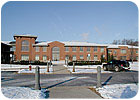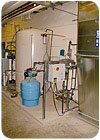
NSF International is in the business of writing standards for and certifying a wide range of products and consumer goods, so consistency and continuity are essential to protecting a reputation. When the Michigan company needed a humidification retrofit, it needed a system to maintain testing conditions; what it got saved operating expenses and reduced labor as well. See how the project performed and learn some in’s and out’s of adiabatic design and installation along the way.
Critical environments such as cleanrooms, laboratories, data centers, and pharmaceutical manufacturing facilities use large amounts of energy to keep their temperatures and relative humidities at precise levels. The need for strict control of space conditions is necessary because even small swings in temperature and humidity can hurt the quality of a product or process.
While each highly controlled environment utilizes a different type of process and variation in the HVAC system design, it has been estimated that HVAC energy use usually accounts for over 50% of the total facility energy in critical applications. While fans often account for a significant portion of the HVAC energy use, there’s no question that humidification can add to the total bill as well.
In an effort to cut utility costs, some facilities that require humidification are being retrofitted with adiabatic systems, which are known for using less energy. Adiabatic system manufacturers state this type of humidification also provides close control of an environment and requires little maintenance, which makes them perfect for critical applications.
Fogging Solutions
Adiabatic systems involve atomizing water into very small droplets before dispersing the moisture into the environment. High-pressure fog technology, which is one type of adiabatic system, forces water at a very high pressure through special stainless steel nozzles, which atomize the water into billions of super fine fog droplets. These tiny droplets measure in the range of 10 microns in diameter, and some nozzles generate more than five billion super fine drops per second.
High-pressure fogging systems utilize a positive displacement pump, which delivers clean water at 1,000 to 2,000 psi to a series of fog nozzles, which are usually installed in air ducts or in the AHU. A typical fog nozzle has an orifice diameter of five to seven thousandths of an inch. Water jets out of the orifice and hits the impaction pin, which breaks the water stream up into billions of super fine fog droplets. High-pressure solenoids are used to control the capacity at each load by opening or closing various combinations of valves connected to varying amounts of capacity.
This type of system is very well-suited to critical applications, said Larry Cluchey, P.E., vice president of sales marketing for Mee Fog, because the capacity at each load can be controlled by the BAS. “In addition, the low energy and maintenance requirements of the Mee Fog system generates large energy savings over steam systems. This is because the system doesn’t use the 1,000 Btu of energy needed to convert water to steam for atomization, and the high-pressure pump produces the atomization energy needed for one-one hundredth of the cost to make steam.”
For these reasons, many facility managers and building owners are now considering adiabatic humidification systems. Cluchey stated that the skyrocketing cost of energy over the last two or three years has spurred many people to consider other alternatives. “There used to be a big difference between the cost of gas and electricity, but that’s not the case anymore. Facility managers are interested in seeing the energy savings our systems can offer, while the building engineers are interested to see the greatly reduced maintenance requirements of our systems.”

NSF Retrofit
One facility that recently changed from a gas-fired system to an adiabatic system is NSF International (Ann Arbor, MI), which helps protect the public by certifying products and writing standards for food, water, and consumer goods. Their laboratories test thousands of products each year, and these labs require close environmental control to maintain the integrity of the testing process and to not introduce any variables into the results.
The NSF facility was built in 1999, and its humidity levels need to be controlled at a uniform level so the testing of products is not affected by humidity swings. Most of the labs are controlled to 35% rh and one lab is controlled to 50% rh. The labs all have exhaust hoods that remove large amounts of air.
Nine gas-fired steam generators originally humidified the lab area and supporting office areas at NSF. In addition, the gas-fired humidification system was causing some problems that had to be rectified.
The existing steam units at the lab were only five years old, but the heat exchangers were plugged up and needed to be replaced. “They were constantly cleaning them,” said Cluchey. “The heat exchangers would then start leaking, and it got to the point where they threw up their hands, and that’s when they called me.”
When the decision was made in 2004 to look at alternate methods of humidification, NSF contacted Mee Fog to help them design a humidification system that would provide the humidity control they desired in an energy efficient manner.
Cluchey showed the personnel at NSF what their cost savings would be over a 10-yr period, based on a computer program he wrote many years ago to model the energy savings a facility will experience if it installs a Mee Fog system. The program bases the system design on a particular locality, then an energy analysis is performed based on the customer’s system. “We model their system quite accurately, then we can show them what energy will be used over 10 years compared to the energy that will be consumed by whatever they have now. That’s an eye-opener for them.”
Seasonal Use
The NSF facility has four air handlers rated at 30,000 cfm each, with two units operating as 100% makeup air units for the lab exhausts and two operating on economizer cycles for the office and support areas. The two makeup air handlers have a load of approximately 1,000 lb/hr, and the two units that serve the offices have a load of 300 lb/hr each.
The humidification load in the Midwest is seasonal, with the season starting about the middle of September and ending the middle of April. The full-load humidification hours for the NSF are approximately 3,000 hrs/season for a standard economizer based system operating at 35% rh in the space, while the full-load operating hours for the makeup units are 4,700 hrs/season.
The adiabatic humidification system that was designed for the facility consists of a single high-pressure pump rated at 5.0 hp and 7 gpm at 1,000 psi. Once the water reaches 1,000 psi, it is distributed via stainless steel tubing to the air handlers. Each air handler has a remote solenoid panel that controls the amount of fog output to match the load. Excess moisture that is not absorbed into the airstream is collected on the cooling coil and drained away.
“We generally like to place the nozzles inbetween the cooling coil and the heating coil in the air handler. That’s a friendly place as far as air velocity and laminar flow go,” said Cluchey. “Our nozzle headers will run close to the cooling coil and point up at a 45-degree angle with the airstream just to enhance the mixing.”
The Siemens BAS controls the staging solenoids at each air handler and also starts the high-pressure pump on a call for humidity from any of the air handlers. As the humidity level changes in the controlled space, the BAS brings on different combinations of staging solenoids to match the load.
The pump unit is controlled by a VFD that is operated by a discharge pressure transducer. This allows the pump speed to slow down or speed up according to discharge pressure, which is directly related to the load. As the load goes up, more water is needed to maintain the discharge pressure so the pump speeds up and visa versa when the load goes down. The BAS monitors the space humidity levels and will send an alarm if low humidity is detected.
All adiabatic humidification systems require water treatment to remove the dissolved minerals and solids, because without such treatment, dissolved minerals in the water will deposit on the coils and final filters as the water evaporates. The NSF water treatment system consists of pre-treatment carbon and water softeners, an RO system, water storage and re-pressurization, and a water sterilization UV unit on the system discharge. The positive displacement pump has a regulator to control discharge pressure, and the relief water from the regulator is piped back to the RO water storage tank. In this manner, the water in the tank is constantly being passed by the UV light, which keeps the water fresh.
Conversion Issues And Savings
Converting air handlers from steam to adiabatic systems is generally straightforward, said Cluchey, providing there is enough space in the air handler to accept the new adiabatic system. Fortunately, there were no space issues at NSF, and the conversion went smoothly. No building or air handler modifications were required at the facility, with the exception of removing the existing steam units, flue piping, gas lines, and steam dispersion headers in the air handlers.
Generally speaking, adiabatic systems need a little more space than steam due to the longer absorption time needed. In a steam system, as the steam is introduced into the colder airstream, the steam immediately condenses to water particles and gives up approximately 1,000 Btu/lb. This heat is added to the airstream, thus warming it. This warmer air is friendlier to the water particles, which results in the water being absorbed more quickly.
In an adiabatic system, the water is introduced into the airstream at ambient temperatures, so the absorption of the water uses approximately 1,000 Btu/lb of water. This heat is taken from the airstream, which results in a cooling effect on the air. On economizer-based systems, the economizer controller detects the lower temperature, reduces the amount of outside air, and increases the amount of return air to provide the heat to warm the discharge air up again.
The adiabatic system at NSF has resulted in annual energy savings of approximately $75,000 (based on 2004 gas prices) compared to steam humidifiers. The facility’s annual maintenance costs have also been reduced another $18,000, due to the fact that the adiabatic system only requires changing the pump oil on a routine basis, and changing the filter on the inlet to the Mee Fog unit and the RO unit. Cluchey estimated the annual maintenance requirement is less than 10 hrs.
NSF is obviously pleased with its new humidification system, because it just completed a 50,000-sq-ft building addition, and a similar system was installed to humidify the new space. ES
